São Paulo – Brazilian artist Tarsila Schubert runs a creative studio in Dubai Design District. Four years ago, Schubert founded The Cave DXB, which provides different artists a space to develop their works. “Our goal was sharing a space and making it possible for everyone to have their studio in a more affordable way,” she told ANBA. Dubai-based, Schubert also travels the world for work. In the picture above, she was in Milan.
People from different countries share the space. The Cave DXB has received artist from Slovenia, New Zealand, Lebanon, Syria, and Romania. It also exhibits and displays works by Brazilian artists such as Fernando Chamarelli and photographer Camila Schubert, Tarsila’s sister.

Before the pandemic, The Cave was divided into nine studios, but the crisis caused some artists to leave the space. Now, five of them have maintained their studios there, and there are spaces available for new artists.
The creative house, as The Cave DXB is defined, has existed since 2016, when the Brazilian decided to expand her work and receive more artists. “I started with my own space. The Cave was supposed to be a space to produce together, but I started by providing consulting, hosting workshops, curating, and it got bigger,” says Schubert, who has had a Dubai-based foreign artist partner for a year and a half.
Street Art in Dubai

In addition to all The Cave’s work fronts, the Brazilian also works with street artist in her individual artistic career. The art came into Shubert’s life when she started living with her grandmother. While growing up, she lived with her parents in different cities, until they moved to Bolivia, while she and her sister went to live with their grandmother in Bauru, São Paulo.
“My grandmother was a painter, but a more academic one. I started learning how to paint with her. I wanted to study Visual Arts but eventually was accepted into Dental school at a private college. When we had financial troubles, my grandmother said, ‘Why don’t you make some paintings and sell them to help you pay for it?’” the 32-year-old artist recalled. She sold the entire first batch of paintings. “I believe may friends supported me quite a bit,” she said.

One year after her first exhibition, Tarsila dropped out Dental school and started learning about street art and spray techniques with her friends. The experiences made her discover other forms of expression. “My boyfriend at the time worked with visual arts, 3D and projection. He and a friend of ours taught me animation. I did some work with them, including the New Year’s Eve in Rio de Janeiro, when we met someone from Dubai. He said he was looking for artists for a job and that they would have to move to Dubai within a month. We thought that was weird, but my boyfriend decided to go first to see how it worked. One month later I came,” she said.
She moved to the country for the eight-month project, but ended up staying in the emirate, where she has lived for almost nine years. “I started working hard because I wouldn’t go back to Bauru. I started a portfolio and sent it to all galleries I could find. One answered me and then I moved here for real, and things started happening. It was all very organic,” she says.
The artist says that, when she moved in 2012, she couldn’t find any incentive for this art. In 2014, she and other artists obtained their first permit to work with a mural. “I made my first public wall during a festival. Since then, murals, which were strictly forbidden, started being encouraged. At first, the most hired artists were pop-art and realist ones. Now, there is an investment for this kind of art, which is a positive marketing for Dubai,” she said.

As the country opened for street art projects, the Brazilian managed to develop her own festival. “I made a festival in the Design District with murals and installations. There were still some trouble getting a permit, and the arts were more abstract, but the artistic freedom is much bigger now,” she says about the event she developed in 2017 and still has some works exhibited around the district. “For the following years, I believe that it will get even better. I have a positive outlook,” she finished.
With the crisis and the lockdown, the events the gallery had schedule for this year are still suspended. But for now, besides keeping producing and developing online projects with other artists, the Brazilian is participating in a campaign to support the victims of the explosion in the Port of Beirut, Lebanon, earlier this month. The campaign is being shared on Tarsila’s social media and is a collaboration with art space The Workshop DBX. “We can help Lebanon recover from this catastrophe. One hundred percent of the proceeds from these prints will be donated to non-governmental organizations,” she said. One work that the artist is donating in support of Lebanon can be seen on her Instagram account.
Translated by Guilherme Miranda




